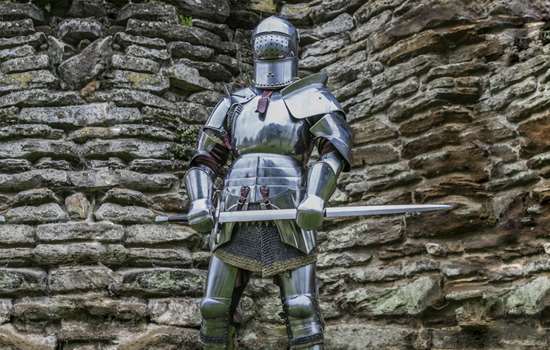1. The earliest tournaments had no rules
Tournaments originated in northern France and took a form similar to battle. Two opposing small armies of knights rode on horseback against each other in ferocious warfare. No rules were enforced and knights could use any tactic to obtain victory. Nothing discouraged several knights from grouping together in order to ambush one opponent, or from ordering their foot soldiers to drag an enemy off their horse. Unsurprisingly these matches were bloody and deaths were not uncommon, one tournament recorded 60 fatal casualties.
2. Tournaments could be extremely profitable
Tournaments began to occur in England in the mid 1100s and continued to be a popular spectator sport until the 1620s. Competitors consisting of knight and nobles sought to win fame, honour and prizes. Victors could emerge substantially wealthier than they were at the start of the tournament, as beaten knights forfeited their valuable horse, armour and often paid a ransom. Young William Marshal —who began as a penniless but skilful knight and finished up as Regent of England — made his fortune at tournaments, capturing over 100 knights in just two months.
3. The church condemned tournaments
From their earliest days, most people viewed these violent and chaotic tournaments as good training for war. However, the church took a stance against tournaments, claiming that they were temptations to sin and a distraction from crusading. The church even went as far as to condemning them as ‘inventions of the devil’ and knights killed in them were forbidden burial in holy ground. This disapproval of the church and the deadly feuds and riots which often followed these tournaments led to King Henry II (1154-89) banning them altogether. Tournaments were restored in 1194 by Henry II’s son Richard the Lionheart, but they were only permitted under strict conditions.
4. Knights fought for the honour of their chosen lady
Over the next three centuries tournaments evolved to provide safer competition and regulated jousting became the main attraction. Two jousting knights rode at each other with 12 foot long lances in their right hands, slanted across their body aiming to strike their opponent’s left side. Victory was awarded to the knight with the most points, obtained by knocking an opponent off their horse, hitting the crest on his helmet, striking lance-point to lance-point, or surviving the greatest number of jousts undefeated. However, striking an opponent’s horse meant instant disqualification. Jousts were especially popular with spectators, and ladies now played an important part in tournaments. Knights fought for the honour of their chosen lady, and prizes — a ring, a jewel or perhaps a kiss — might be presented by a ‘Queen of Beauty’.
5. Jousting was an expensive and physically demanding hobby
Jousting knights needed to be extremely athletic, riding in armour weighing over 40kg, at speeds of up to 30mph, and the sport demanded a great deal of specialist equipment. Knights needed a strong, trained horse (a ‘destrier’ or ‘courser’) capable of carrying the immense weight of an armoured knight, his saddle, his weapons and (in the later days of tournaments) its own horse armour. A knight’s jousting armour included reinforcements for the left shoulder, where the lance struck, and ‘frog mouth' jousting helmets, designed to maximise protection at the cost of visibility. All this equipment was very costly, and eventually only the wealthiest of knights could compete in tournaments.
Queen Elizabeth I’s reign saw the tournament’s last blaze of glory, as favourites like Robert Dudley spent fortunes impressing the Virgin Queen with their skill, style, fabulously expensive armour and lavish fantasy outfits. The last traditional tournament in England was held in the 1620s.
MORE TO EXPLORE
-

5 Things You Might Not Know About Knights
Currently knighthood is granted by the Queen in recognition of a great achievement. Pop culture would have you believe that the knights of old were gallant, chivalric heroes. But how accurate is this depiction?
-

History at Home
Discover the best stories from England’s past, from videos and podcasts to old-fashioned recipes and historical how-tos.
-

THE ENGLISH HERITAGE PODCAST
Join presenter Charles Rowe as we bring the history of our sites to life with news, views and expert interviews across over 100 episodes.
